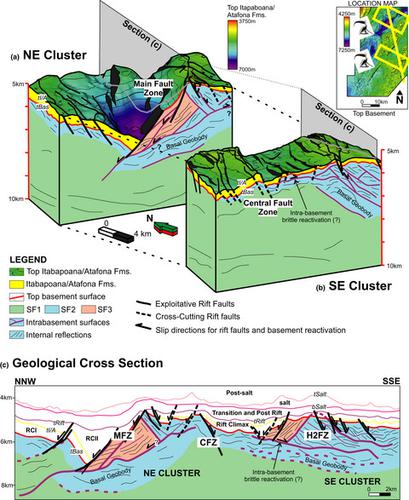当前位置:
X-MOL 学术
›
Basin Res.
›
论文详情
Our official English website, www.x-mol.net, welcomes your feedback! (Note: you will need to create a separate account there.)
Basement geology and its controls on the nucleation and growth of rift faults in the northern Campos Basin, offshore Brazil
Basin Research ( IF 3.2 ) Pub Date : 2021-01-15 , DOI: 10.1111/bre.12540 Michael Strugale 1, 2 , Renata da Silva Schmitt 3 , Joe Cartwright 2
Basin Research ( IF 3.2 ) Pub Date : 2021-01-15 , DOI: 10.1111/bre.12540 Michael Strugale 1, 2 , Renata da Silva Schmitt 3 , Joe Cartwright 2
Affiliation

|
The rift phase of the Campos Basin developed during the Early Cretaceous on a heterogeneous crust comprising structures inherited from the Brasiliano-Pan African tectonic events, mostly generated during the Neoproterozoic-Cambrian amalgamation of western Gondwana blocks. The main rifting episode took place from the Hauterivian to the Barremian, then was succeeded by the transition and post-rift (SAG) phases during the Aptian. Rift faults developed as a result of a progressive rotation of extension from E-W to NW-SE. The role of pre-existing intra-basement structures on the style and evolution of the rift faults was investigated using 3D high-resolution seismic data, borehole logs and sidewall samples. Three seismic facies (SF1, SF2 and SF3) and three types of intra-basement structures (Surfaces, Geobodies and Internal Reflections) were identified and mapped. They represent, respectively, contrasting levels of seismic anisotropy, interpreted as metamorphic foliation, and ductile shear zones that bound rock units with particular seismic facies signatures. Sidewall cores show that banded biotite-gneiss is the predominant rock type in the eastern half of the study area, while more homogeneous granitoid is the dominant lithology on the west. Such a binary division of lithotypes is consistent with the distribution of mapped intra-basement seismic facies and features. The contrasting basement heterogeneity across the study area is the major control in the strain distribution during rifting. Where the basement is highly heterogeneous, the pre-existing fabric was selectively reactivated whenever its orientation was favourable, resulting in faults forming progressively as the extension direction rotates, whilst shallower low to very low angle basement fabric were cross-cut by rift faults. Where the basement is homogeneous, only early formed faults remain active throughout the rifting.
中文翻译:

巴西近海坎波斯盆地北部裂谷断层成核和生长的基底地质及其控制
坎波斯盆地的裂谷期是在早白垩世形成的异质地壳上,该地壳包括从巴西利亚—潘大地构造事件中继承的结构,大部分是在冈瓦纳西部的新元古代—寒武纪合并过程中产生的。主要的裂谷事件发生在从上特韦期到巴雷米亚时期,然后是阿普提安时期的过渡期和裂谷后阶段(SAG)。从EW到NW-SE的扩展旋转逐渐形成了裂谷断层。使用3D高分辨率地震数据,井眼测井和井壁样品,研究了预先存在的内部基底结构对裂谷断层的样式和演化的作用。三种地震相(SF1,SF2和SF3)和三种类型的基底内部结构(地表,确定并绘制了地体和内部反射)。它们分别代表了地震各向异性的对比水平(被解释为变质岩层)和韧性剪切带,这些剪切带将具有特定地震相特征的岩石单元束缚起来。侧壁岩心表明,带状黑云母片麻岩是研究区域东半部的主要岩石类型,而更均质的花岗岩类是西部的主要岩性。岩性的这种二元划分与测绘的基底内地震相和特征的分布是一致的。研究区域相反的基底异质性是裂谷过程中应变分布的主要控制因素。在地下室高度异质的情况下,只要其朝向有利,就可以选择性地重新激活先前存在的织物,导致断层随着延伸方向的旋转而逐渐形成,而较浅的低至极低角度的基底织物则被裂谷断层横切。在地下室均质的地方,只有早期形成的断层在整个裂谷活动中仍然活跃。
更新日期:2021-01-15
中文翻译:

巴西近海坎波斯盆地北部裂谷断层成核和生长的基底地质及其控制
坎波斯盆地的裂谷期是在早白垩世形成的异质地壳上,该地壳包括从巴西利亚—潘大地构造事件中继承的结构,大部分是在冈瓦纳西部的新元古代—寒武纪合并过程中产生的。主要的裂谷事件发生在从上特韦期到巴雷米亚时期,然后是阿普提安时期的过渡期和裂谷后阶段(SAG)。从EW到NW-SE的扩展旋转逐渐形成了裂谷断层。使用3D高分辨率地震数据,井眼测井和井壁样品,研究了预先存在的内部基底结构对裂谷断层的样式和演化的作用。三种地震相(SF1,SF2和SF3)和三种类型的基底内部结构(地表,确定并绘制了地体和内部反射)。它们分别代表了地震各向异性的对比水平(被解释为变质岩层)和韧性剪切带,这些剪切带将具有特定地震相特征的岩石单元束缚起来。侧壁岩心表明,带状黑云母片麻岩是研究区域东半部的主要岩石类型,而更均质的花岗岩类是西部的主要岩性。岩性的这种二元划分与测绘的基底内地震相和特征的分布是一致的。研究区域相反的基底异质性是裂谷过程中应变分布的主要控制因素。在地下室高度异质的情况下,只要其朝向有利,就可以选择性地重新激活先前存在的织物,导致断层随着延伸方向的旋转而逐渐形成,而较浅的低至极低角度的基底织物则被裂谷断层横切。在地下室均质的地方,只有早期形成的断层在整个裂谷活动中仍然活跃。



























 京公网安备 11010802027423号
京公网安备 11010802027423号